Complete Solutions to SECTION-II of chapter SAMPLE PAPER 2011 of Class 10 book with complete answers and questions
| Class 10 | BIOLOGY |
| Chapter | SAMPLE PAPER 2011 |
| GURUKUL | SECTION-II |
| Number Of Questions | 52 |
| Academic Year | 2023-24 |
Study the diagram given below and then answer the questions that follow :

Name the region in the kidney where the above structure is present.
View SolutionStudy the diagram given below and then answer the questions that follow :

Name the parts labelled 1, 2, 3 and 4.
View SolutionStudy the diagram given below and then answer the questions that follow :
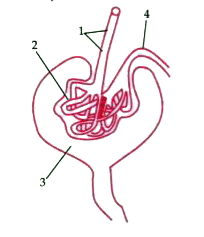
Name the stages involved in the formation of urine.
View SolutionStudy the diagram given below and then answer the questions that follow :

What is the technical term given to the process occurring in 2 and 3 ? Briefly describe the process.
View SolutionGive reason for the following
Photosynthesis is considered as a process supporting all life on earth.
View SolutionGive scientific reasons for the following statements:
Loss of nucleus and mitochondria make erythrocytes more efficient in their function.
View SolutionGive reasons :
Potato cubes when placed in water become firm and increase in size.
View SolutionComment upon the following:
The urine is slightly thicker in summer than in winter.
View SolutionComment upon the following :
People living in hilly regions usually suffer from simple goitre.
View SolutionStudy the diagram given below and then answer the questions that follow:

(I) Name the cells of the pancreas that produce (a) glucagon (b) insulin.
(ii) State the main function of (a) glucagon (b) insulin.
(iii) Why is the pancreas referred to as an exo- endocrine gland ?
(iv) Why Is insulin not given orally but is injected into the body ?
(vj What is the technical term for the cells of the pancreas that produce endocrine hormones?
(vi) Where in the body is the pancreas located?
View SolutionStudy the diagram given below and then answer the questions that follow :

State the main function of (1) glucagon, (2) insulin.
View SolutionStudy the diagram given below and then answer the questions that follow :

Why is the pancreas referred to as an exoendocrine gland ?
View SolutionStudy the diagram given below and then answer the questions that follow :

Why is insulin not given orally but is injected into the body ?
View SolutionStudy the diagram given below and then answer the questions that follow :

What is the technical term for the cells of the pancreas that produce endocrine hormones ?
View SolutionStudy the diagram given below and then answer the questions that follow :

Where in the body is the pancreas located ?
View SolutionWith reference to the functioning of the eye, answer the questions that follow :
What is meant by power of accommodation of the eye?
View SolutionWith reference to the functioning of the eye, answer the questions that follow :
What is the shape of the lens during :
(a) near vision (b) distant vision ?
View SolutionWith reference to the functioning of the eye, answer the questions that follow :
Name the two structures in the eye responsible for bringing about the change in the shape of the lens.
View SolutionWith reference to the functioning of the eye, answer the questions that follow :
Name the cells of the retina and their respective pigments which get activated :
(a) in the dark (b) in light.
View SolutionGiven below the simplified pathway of the circulatory system of man:
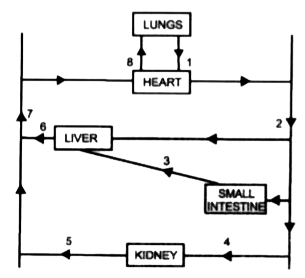
Name the blood vessels labelled 1. 3. 6. and 7.
View SolutionGiven below the simplified pathway of the circulatory system of man:

Name the blood vessel that supplies the walls of the heart with oxygen.
View SolutionGiven below the simplified pathway of the circulatory system of man:

Draw a neat labelled diagram of the blood vessel numbered 2' as seen in a cross-section.
View SolutionGiven below is a diagrammatic representation of a certain part of the process of circulation of blood in man. Study the same and then answer the questions that follow :
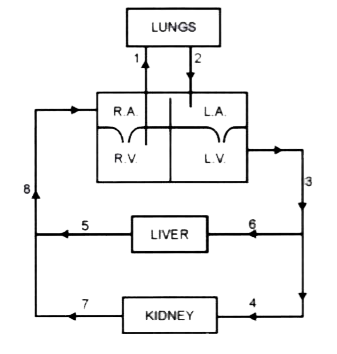
Mention two structural differences between blood vessels '3' and '8
View SolutionWith reference to the human ear, answer the questions that follow :
Give the technical term for the structure found in the inner ear.
View SolutionWith reference to the human ear, answer the questions that follow :
Name the three small bones present in the middle ear. What is the biological term for them collectively?
View SolutionWith reference to the human ear, answer the questions that follow :
Name the part of the ear associated with
(a) static balance (6) hearing (c) dynamic balance.
View SolutionWith reference to the human ear, answer the questions that follow :
Name the nerve, which transmits messages from the ear to the brain.
View SolutionThe diagram given below represents two reproductive cells A and B. Study the same and then answer the questions that follow:

(i) Identify the reproductive cells A and B.
(ii) Name the specific part of the reproductive system where the above cells are produced
(iii) Where in the female reproductive system do these cells unite ?
(iv) Name the main hormones secreted by the (1) ovary (2) testes.
(v) Name an accessory gland found in the male reproductive system and state the function of its secretion.
View SolutionThe diagram given below represents two reproductive cells A and B. Study the same and then answer the questions that follow:

(i) Identify the reproductive cells A and B.
(ii) Name the specific part of the reproductive system where the above cells are produced
(iii) Where in the female reproductive system do these cells unite ?
(iv) Name the main hormones secreted by the (1) ovary (2) testes.
(v) Name an accessory gland found in the male reproductive system and state the function of its secretion.
View SolutionThe diagram given below represents two reproductive cells A and B. Study the same and then answer the questions that follow:

(i) Identify the reproductive cells A and B.
(ii) Name the specific part of the reproductive system where the above cells are produced
(iii) Where in the female reproductive system do these cells unite ?
(iv) Name the main hormones secreted by the (1) ovary (2) testes.
(v) Name an accessory gland found in the male reproductive system and state the function of its secretion.
View SolutionThe diagram given below represents two reproductive cells A and B. Study the same and then answer the questions that follow:

(i) Identify the reproductive cells A and B.
(ii) Name the specific part of the reproductive system where the above cells are produced
(iii) Where in the female reproductive system do these cells unite ?
(iv) Name the main hormones secreted by the (1) ovary (2) testes.
(v) Name an accessory gland found in the male reproductive system and state the function of its secretion.
View SolutionThe diagram given below represents two reproductive cells A and B. Study the same and then answer the questions that follow:

(i) Identify the reproductive cells A and B.
(ii) Name the specific part of the reproductive system where the above cells are produced
(iii) Where in the female reproductive system do these cells unite ?
(iv) Name the main hormones secreted by the (1) ovary (2) testes.
(v) Name an accessory gland found in the male reproductive system and state the function of its secretion.
View SolutionThe given diagram represents a layer of epidermal cells showing a fully-grown root hair. Study the diagram and answer the questions that follow :
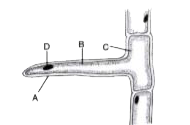
Name the parts labelled A, B, C and D.
View SolutionThe given diagram represents a layer of epidermal cells showing a fully-grown root hair. Study the diagram and answer the questions that follow :
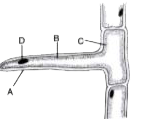
The root hair cell is in a turgid state. Name and explain the process that caused this state .
View SolutionThe given diagram represents a layer of epidermal cells showing a fully-grown root hair. Study the diagram and answer the questions that follow :

Mention one distinct difference between the parts labelled A and B.
View SolutionThe given diagram represents a layer of epidermal cells showing a fully-grown root hair. Study the diagram and answer the questions that follow :

Draw a diagram of the above root hair cell as it would appear when a concentrated solution of fertilizers is added near it.
View SolutionThe diagram given below represents a stage during cell division. Study the same and then answer the questions that follow :

Name the parts labelled 1, 2 and 3.
View SolutionThe diagram given below represents a stage during cell division. Study the same and then answer the questions that follow :
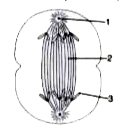
Identify the above stage and give a reason to support your answer.
View SolutionThe diagram given below represents a stage during cell division. Study the same and then answer the questions that follow :

Mention where in the body this type of cell division occurs.
View SolutionThe diagram given below represents a stage during cell division. Study the same and then answer the questions that follow :

Name the parts labelled 1, 2 and 3.
View SolutionStudy the diagram given below and answer the questions that follow :

Name the process being studied in the experiment.
View SolutionStudy the diagram given below and answer the questions that follow :

Name the process being studied in the experiment.
View SolutionStudy the diagram given below and answer the questions that follow :

Why is oil placed over water
View SolutionStudy the diagram given below and answer the questions that follow :

What do we observe with regard to the level of water when this set-up is placed in (1) bright sunlight (2) humid conditions (3) windy day
View SolutionStudy the diagram given below and answer the questions that follow :

Mention any three adaptations found in plants to overcome the process studied in the experiment. .
View SolutionGiven below is a table comparing the effects of sympathetic and parasympathetic nervous system for four feature (1-4). Which one feature is correctly described ?

View SolutionList four major activities of the Red Cross.
View SolutionDefine antiseptics and disinfectants. How do these differ? Give one example of a substance which acts both as an antiseptic and disinfectant.
View SolutionWrite down the difference between the following pairs as indicated within the brackets :
Erythrocytes and leucocytes (function).
View SolutionWrite down the difference between the following pairs as indicated within the brackets :
Guttation and bleeding in plants (cause)
View SolutionExpand the abbreviation :
NADP
View SolutionDifferentiate as directed :
Monohybrid and Dihybrid cross (Phenotypic ratio)
View Solution
SECTION-II questions and complete solutions for chapter SAMPLE PAPER 2011 of EVERGREEN BIOLOGY (ENGLISH) of Class 10